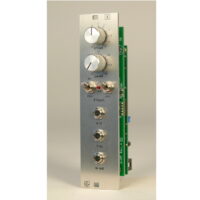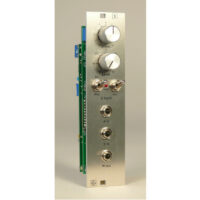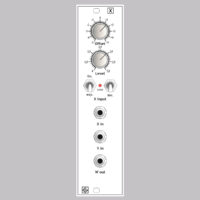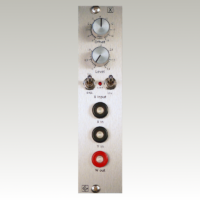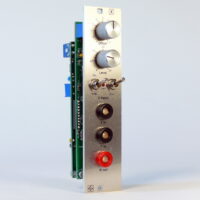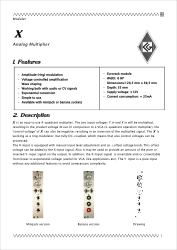Eurorack Module
X
4-Quadrant Multiplier
-
Ring or amplitude modulation
-
Voltage controlled amplification
-
Exponential conversion
-
Wave shaping
-
Dynamic expansion
-
One input with adjustable level and offset control
-
Works both with audio and CV signals
-
Red LED for overdrive indication
-
Easy to use
-
Width: 6 HP
-
Dimensions: 128,5 mm x 30,2 mm
-
Depth: 35mm
-
Supply voltage: ±12V
-
Current: +12V: ≈33mA; -12V: ≈31mA
-
Optionally with banana or 3,5mm minijack
The amplitude multiplier module X is multiplying the two applied input voltages X in and Y in. A multiplication of 2 both positive or both negative input voltages will result in a positive output voltage, while a multiplication of 1 negative and 1 positive signal input will generate a negative output signal (phase inversion). The results are ring/amplitude modulated sounds or control voltages.
» read more
One of the input, X in, is equipped with several manual control options: A switchable exponential converter for VCA-like applications etc.; a Level knob to amplify or attenuate the input signal, an inversion switch and an adjustable Offset voltage, which can be added to this input. The offset knob is also allowing a ‘dry/wet’ style control over the Y input and the modulated signal, or may be used to shift the multiplier’s working point. In addition, there is a little red LED indicating when this input is becoming overdriven.
In comparison with the 1st input X in, the 2nd input Y in has no extra features or controllers – to reduce the complexity and keep the handling more simple.
The output (W out) is internally attenuated to ensure that the product voltage of X×Y is almost in the range between the ±12V voltage supply.
4-quadrant means: In comparison to a common VCA (2-quadrant operation), a multiplier is processing both positive and negative (control) voltages, causing a ± polarity inversion of the modulated signal for input voltages with unequal polarities (≙ 4-quadrant operation). » read less
» read more
In comparison with the 1st input X in, the 2nd input Y in has no extra features or controllers – to reduce the complexity and keep the handling more simple.
The output (W out) is internally attenuated to ensure that the product voltage of X×Y is almost in the range between the ±12V voltage supply.
4-quadrant means: In comparison to a common VCA (2-quadrant operation), a multiplier is processing both positive and negative (control) voltages, causing a ± polarity inversion of the modulated signal for input voltages with unequal polarities (≙ 4-quadrant operation).
» read less
Soundfiles
Ringmodulation of synthesizer and rhythm machine
X in: Korg MS-20 filtered VCO and noise with different filter settings;Y in: Rhythm machine
Ringmodulation of rhythm machine and trumpet
X in: Rhythm machine; Y in: Preamplified trumpet; different X Offset settings
Ringmodulation of rhythm machine and cymbals
X in: Rhythm machine; Y in: Preamplified cymbals; different X Offset settings
Stereo panorama control with 2 X modules X in 1: triangle/squarewave, X in 2: triangle/squarewave inverted;
Y in 1+2: Rhythm machine / VCO
Envelope shaping with 2 X modules X in1+X in2: trianglewave; Y in 1: VCO; Y in 2: Noise
In exponential mode, depending on X Offset and X Level settings, different modulation waveforms can be achieved.
Noise modulation with 2 X modules and Delay1022 Xin1+Xin2 (exponential mode): pink noise, Yin1: white noise; W out1: Delay In
Y in2: +10V DC voltage W out2: Delay time CV input
Multiplier 1 (modulating white noise) is followed by the delay (delay time modulated by multiplier 2)
Or listen on
https://soundcloud.com/cg-products/sets/x
Block Diagram
Examples (linear mode)
Linear mode: switch ‘lin/exp.’ in upper position
| X in or Y in = 0 ⇨ W out = 0 | X in polarity ≠ Y in polarity ⇨ W out = negative | |||||
|---|---|---|---|---|---|---|
| X in | 0 | ± | + | + | − | − |
| Y in | ± | 0 | + | − | + | − |
| W out | 0 | 0 | + | − | − | + |
| X Offset | X in | Y in | W out |
|---|---|---|---|
| 0 |  |
 |
 |
| +2 |  |
 |
 |
| +4 |  |
 |
 |
Examples (exponential mode)
X Level: ≈3 (≙ X in amplification ≈ 1); exponential mode: switch ‘lin/exp.’ in lower position
| X Offset | X in | Y in | W out |
| +3,5 |  |
 |
 |
Due to the rectifying characteristic of the exponential mode, with different settings of the X input level and X offset several modulation shapes can be achieved for Y in (Y in: +10V DC voltage)
| X Offset | X in Level | X in (ca. 8V pp) | W out |
| +3,5 | 1 |  |
 |
| +2,5 | 2 |  |
 |
| 0 | 4 |  |
 |
| -4 | 7 |  |
 |


